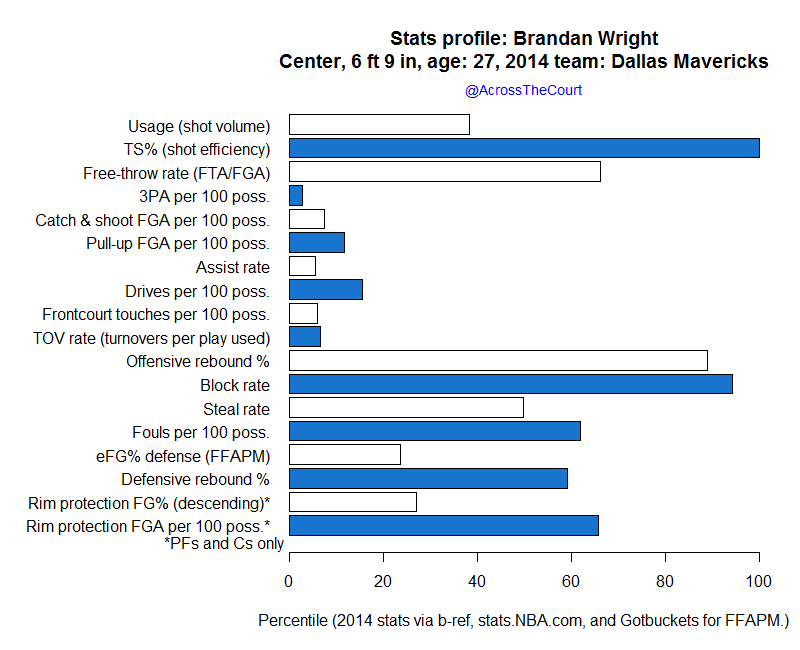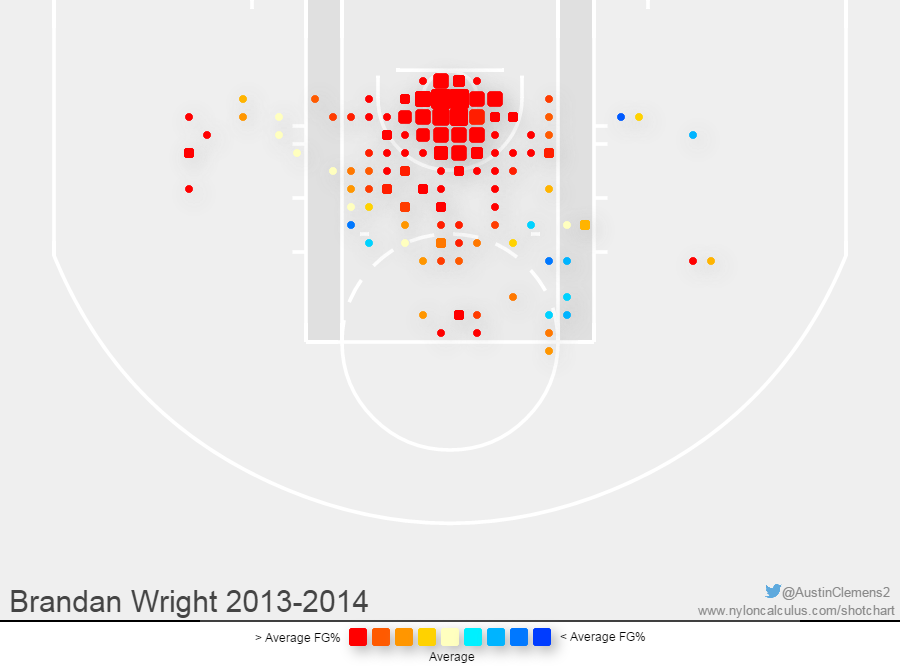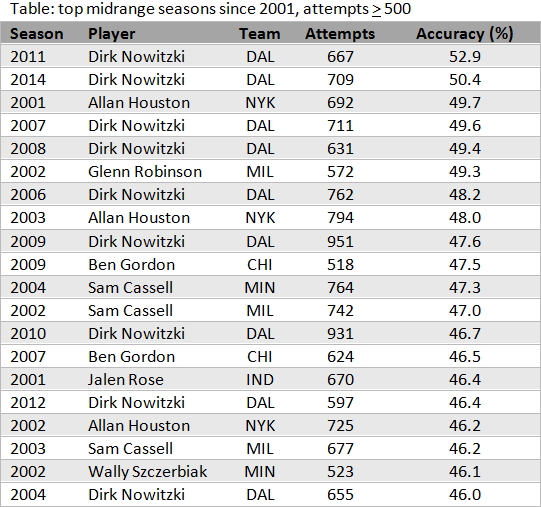Dallas has rarely missed the playoffs in the Dirk-era, but they’ll have another tough fight on their hands. Dallas should be in the mix for one of the lower seeds and the fight is so close that one wrong move or one injury at the wrong time could knock them out. They’re bringing in a couple of big names, the Chandler guys, but with the pieces they’re losing like Vince Carter’s underrated sixth man scoring there’s no huge net change here. The Mavericks, despite half the roster turning away, are mostly the same.
2014 in review
Derided for the Monta Ellis signing, Dallas leveraged a throwback season from Dirk Nowitzki and turned in one of the most potent offenses with a squad of old guys and a few miscellaneous pieces other teams did not want. Ellis, usually criticized for his shot selection, cooled down on some of his most wild tendencies, and used all the defensive attention given to other teammates like Dirk for open midrange jumpers and open lanes to the basket. They used weird lineups effectively, a team known for unconventional methods like a heavier use of zones. Carlisle would have won Coach of the Year with this kind of alchemy in a normal year.
However, some of the criticisms the team received were on target: they had the worst defense for a playoff team in the league, deflating the full power of their offense, ranked third best in offensive efficiency. Ellis and Calderon offered no resistance, and the frontcourt shuffled through old Dirk, Dalembert, Brandan Wright, and DeJuan Blair. Nonetheless, their offense gave the Spurs such fits they took them to seven games, before being blown-out in the seventh game.
Changes
Exit: Jose Calderon, Shawn Marion, Vince Carter, Samuel Dalembert, DeJuan Blair, Shane Larkin, Wayne Ellington, Bernard James.
Enter: Chandler Parsons, Tyson Chandler, Raymond Felton, Jameer Nelson, Al-Farouq Aminu, Richard Jefferson, Greg Smith, Ivan Johnson, Charlie Villanueva.
By the time Dirk Nowitzki retires, he’ll have a mile-long list of former teammates. The Mavericks keep rebuilding around him and return with an almost entirely new cast. They’ve replaced their starting point guard with new ones, and they’re swapping out Dalembert with Tyson Chandler — that alone is big upgrade, even if Tyson doesn’t reset to his DPOTY days. Dallas lost two of its old guys, Carter and Marion, and Aminu will try his best Marion impression. The loss of Vince Carter could impact the bench, but the team hums so well on offense it may not skip a beat.
The other change to the starting lineup is Chandler Parsons, who goes from making $900,000 a year to being the highest paid player on a rich team. Dallas is also adding a large supporting cast too, and it’s difficult to ascertain who will be a major rotation player or not. Jefferson will be the veteran coaches love. Smith and Ivan Johnson could net a lot of time mopping up frontcourt minutes. Lastly, Villanueva’s an all-offense, stretch 4 who could be used in bursts.
Player spotlight
While Greg Oden is known for missing games at an alarming rate, Wright missed 44, 43, 82, and then 45 games, respectively, his first four seasons. But he survived, and he’s one of the truly unique talents in the league. The bar chart below is one of the strangest ones. He’s extremely efficient with no one higher in shooting efficiency, and although he didn’t hit near his 70 TS% in other seasons he’s usually well above average. Coupled with a tiny turnover rate, and he was an absurdly efficient scorer last year — basketball-reference listed his offensive rating at 135. He has a high offensive rebound and free-throw rate too. But he shoots few jump shots, doesn’t throw assists, drove 16 times all year, and has one of the lowest frontcourt touches too. Yet his usage rate isn’t minuscule — he still somehow scores often.
Defensively, Wright is all over the map as well. He’s near the 90th percentile in block rate and picks up a fair number of steals for a guy who mostly plays center. His defensive rebounding is weak for his position, however, and his other defensive marks are weak, not surprising because Wright is used sparingly due to these concerns. Opponents shot well near the rim when he was nearby, and his eFG% defense percentile is awful for a center.
Wright’s shot chart is pretty extreme too. He has a short range and infrequently shoots outside the paint. But he’s one of the best finishers at the rim where within three feet he shoots 74% for his career and hit a LeBron-esque 79%. But he’s good in that awkward, in-between zone from 3 to 8 feet as well. His jump shot might be underutilized because for his career he shoots 43.5% from 10 to 16 feet.
Wright shoots a high-percentage against virtually every team, and there’s a set of videos (link’s also here) against the Spurs below. In the first one, he sets a screen at the three-point line and then rolls to the rim, following up Carter’s miss with a tip-in. The second video starts the same way, but Carter bounces a pass to Wright, who zips by three of the best defenders in the league (Duncan, Splitter, and Leonard) for a lay-up. As Ellis draws Duncan away in the third clip, Wright’s open a couple feet away and receives a pass, hitting a quick hook shot almost point blank. In the last video, Marion’s pass is deflected and Wright catches the ball in no-man’s land, but it’s no problem for him and he hits a short jumper before his defender can challenge him.
On defense, Wright offers no resistance. In the first video versus the Suns and Markieff Moriss in the playlist below, you can see Wright’s Tigger-like bounciness and his length, but he’s actually a little too active and doesn’t set himself in the right spots. He can zoom in front of the guard quickly, and then he’ll forget to contest his man rolling to the rim. In the second video, he jumps out with zeal to help defend a Green post-up, which wasn’t needed, and then Dirk has to pick up his man. Then Wright just … doesn’t defend anyone and watches the ball go up. Coaches probably love his defensive potential, but he’s never been able to harness it.
Brandan Wright is the type of big who can blow up a box-score metric like PER with his absurd efficiency, strong offensive rebounding, and block totals. He rarely touches the ball on offense to initiate anything, and infrequently shoots jumpers. Yet he still manages to score 18 points per 36 minutes, and he’s one of the best at converting inside shots. Wright’s career PER is 20.6, which is supposed to indicate fringe all-star, and it’s because the box score can’t understand an oddity like him. He can have games like this one versus the Lakers where he’s perfect from the floor, going 10 for 10. Box-score stat agnostic metrics are more neutral about him, and aren’t fond of his defense. And that’s probably closer to the truth. He’s great in limited roles, finishing on dives to the rim or on fast breaks, but he doesn’t have much of a range and he’s a liability on defense versus most guys. But between him and Tyson Chandler, you won’t see a lot of missed shots inside.
2015 projected
There’s been a lot of discussion about Chandler Parsons and whether or not he deserves a gargantuan contract. Generally, you don’t want to overpay role players because they can be one injury or one year away from being useless, and they’re replaceable. Parsons hits a few of the advanced stats warning signs: he plays huge minutes, boosting his per game stats; he plays on a fast-paced team, inflating his numbers; and he’s older than you think. Overall, he’s a plus, but it’s doubtful he’ll ever approach all-star status and he’s not going to push them over the top.
The real difference between looking at per game stats and per possession stats is replaceability. Parsons isn’t “adding” 17 points to Dallas. And when he’s out, they aren’t losing 17 either. The shots will be distributed to different players, and it’s all about the difference in how effective those shots are used by Parsons versus everyone else. He’s a fine scorer, but he had a below average usage rate — they aren’t adding a big force here. His defense is nothing special either. Sometimes he’s touted as a “stopper” but there’s little evidence to support that assertion. On the bright side, he’s a good outside shooter, a good passer, and he’s not a poor defender. He’s a glue guy, more or less, and helps you fill out the minutes around your stars; he just isn’t one.
The star is still Dirk, regardless of how much he’s making. I don’t need to remind anyone how good he is. He recovered from a disappointing 2013 and made greater use of his three-point shot than he has in a while, working more off Ellis. (Dirk hasn’t taken that many three’s per possession since Nash played with him in 2003.) Critics will point to his defense and rebounding, but Dirk’s been a solid defender for his career and his size won’t age, while is rebounding numbers are underrated. Since he plays far from the basket, he grabs few offensive rebounds. On defense, he collects rebounds at a 20% rate still, which is fine for a power forward — it was in the 47th percentile last year among big men
The two major pieces around Dirk are Ellis and Tyson Chandler. Ellis was taken at a discount rate, and even if the reclamation project worked he still has a few warts. Dallas had major problems on defense even with a good coach, and he was part of the issue. Chandler is there to save the defense as a backline defender, but too many people are just remembering his last run with Dallas and not how broken he looked last season. He strung together three seasons with an Artis Gilmore-esque true-shooting percentage above 67, and then dropped back down to 61.5. His defense wasn’t Defensive Player of the Year worthy anymore; it was mortal and too often average. The Mavericks dropped him because of injury concerns, and eventually they were right. He’ll still be a better option for them than Dalembert, but any projections should be cautious. Injury problems don’t magically go away when you turn 32.
Two other big pieces they brought in were point guards, Jameer Nelson and Raymond Felton. Those are hardly inspiring signings, but neither was Calderon. Nelson is leaving a rebuilding team in Orlando with few shooters and real pros on offense; Felton escaped from New York and could play decently with a good system. They’ll miss Calderon’s shooting, but there’s no major downgrade here and perhaps the Mavs were hedging their bet. At least one of these two point guards will have a good year, and they’ll play that guy more. Devin Harris is the fourth small guard. In his first stay with the Mavericks, he was a superb defender and impossibly quick — that’s mostly gone now and he probably won’t be a major rotation cog.
The key to Dallas’ defense this season will be Tyson’s health, of course, and the viability of Aminu’s outside shooting. They need another long-armed, athletic defender to throw out there; Parsons isn’t enough. Marion’s versatility will be missed and if Tyson isn’t playing well the defense could get ugly. Elder statesman Richard Jefferson won’t fix that, and he’ll get the backup small forward minutes if Aminu’s shooting is an issue.
There’s little ammunition at the end of the bench in the frontcourt either. Greg Smith has gigantic hands, but he’s too short for a center. Ivan “Drago” Johnson has some defensive chops and hopefully he’ll play enough to show off those skills. He’s a tough, energetic undersized power forward last seen with the Hawks a couple years ago. With him and Bernard James, former Air Force Staff Sergeant, they have some options against physical players inside.
With almost any other coach, this motley collection of talent and odd fits would be an issue, but Carlisle’s a legitimately great coach, one of the few who actually have a positive effect on a team’s win percentage. He still has Dirk with his ultimate weapon: that unblockable fadeaway. In the era of mass three-pointers with fewer two-point jumpers, his shot is a rare art piece, and it perplexes defenses so much that normal box score stats can’t measure him and people lose track of just how valuable it is. He’ll shoot about 50% from the midrange area, year-after-year, with both a high volume and difficulty level. If you look at the top seasons in midrange shooting percentage for players who have at least 500 attempts, it’s hilariously stacked with Dirk Nowitzki seasons.
He’s in a class by himself.
Summary
Dallas can coast for years on Dirk’s offensive game, but there’s a question of how they can best spend their resources. They’ve had a few underrated moves that worked out better than expected for them, but they’ve struck out in providing him with another star player, like Texan Chris Bosh, and settled on Ellis and Chandler Parsons. They won like this in 2011, but Tyson Chandler was all-star caliber back then and they had better defenders all around, including the now absent Marion and Jason Kidd. The offense is still top-notch and that scoring will be hard to slow down. And we’ll get to watch Dirk slowly ascend the career points ladder, 10th now and with his sights set on Hakeem, Elvin Hayes, and Moses Malone next.
Wins: 49
Losses: 33
Conference rank: 6th (tied)
League offense rank: 3rd
League defense rank: 22nd
Edited 10/27/14























